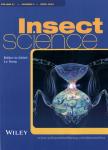RNA interference to reveal roles of β-N-acetylglucosaminidase gene during molting process in Locusta migratoria
RNA interference to reveal roles of β-N-acetylglucosaminidase gene during molting process in Locusta migratoria作者机构:Research Institute of Appfied Biology Shanxi University Taiyuan Institute of Plant Physiology and Ecology Shanghai Institutes of Biological Sciences Chinese Academy of Sciences Shanghai China Department of Entomology 123 Waters Hall Kansas State University Manhattan KS 66506 USA
出 版 物:《Insect Science》 (昆虫科学(英文版))
年 卷 期:2013年第20卷第1期
页 面:109-119页
核心收录:
学科分类:0710[理学-生物学] 071010[理学-生物化学与分子生物学] 081702[工学-化学工艺] 081704[工学-应用化学] 07[理学] 08[工学] 0817[工学-化学工程与技术]
基 金:supported by grants from National Basic Research Program of China International Cooperation and Exchange Program 国家自然科学基金 Science and Technology Research Projects of Shanxi Province Program for Top Young Academic Leaders of Higher Learning Institutions of Shanxi (TYAL) 中国博士后科学基金 上海市博士后科研资助计划项目
主 题:β-N-acetylglucosaminidase chitin degradation Locusta migratoria RNA interference
摘 要:β-N-acetylglucosaminidases are crucial enzymes involved in chitin degrada- tion in insects. We identified a β-N-acetylglucosaminidase gene (LmNAG1) from Locusta migratoria. The full-length complementary DNA (cDNA) of LmNAG1 consists of 2 667 nucleotides, including an open reading frame (ORF) of 1 845 nucleotides encoding 614 amino acid residues, and 233- and 589-nucleotide non-coding regions at the 5'- and 3'- ends, respectively. Phylogenetic analysis grouped the cDNA-deduced LmNAG1 protein with the enzymatically characterized β-N-acetylglucosaminidases in group I. Analyses of stage- and tissue-dependent expression patterns of LmNAG1 were carried out by real- time quantitative polymerase chain reaction. Our results showed that LmNAG1 transcript level in the integument was significantly high in the last 2 days of the fourth and fifth instar nymphs. LmNAG1 was highly expressed in foregut and hindgut. RNA interference of LmNAG1 resulted in an effective silence of the gene and a significantly reduced total LmNAG enzyme activity at 48 and 72 h after the injection of LmNAG1 double-stranded RNA (dsRNA). As compared with the control nymphs injected with GFP dsRNA, 50% of the dsLmNAGl-injected nymphs were not able to molt successfully and eventually died. Our results suggest that LmNAG1 plays an essential role in molting process ofL. migratoria.



